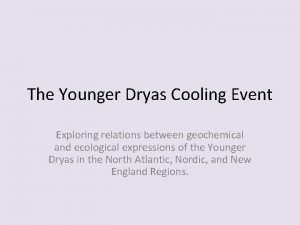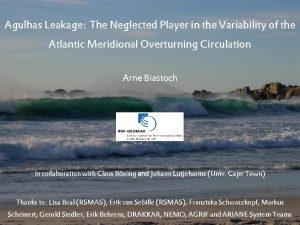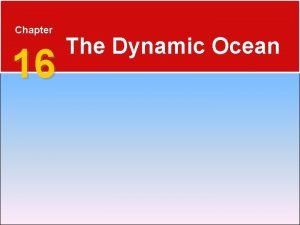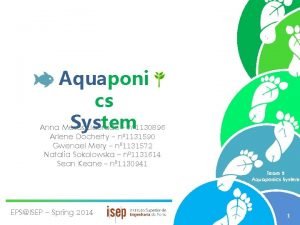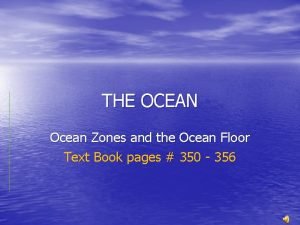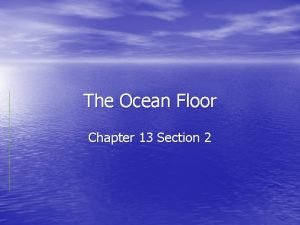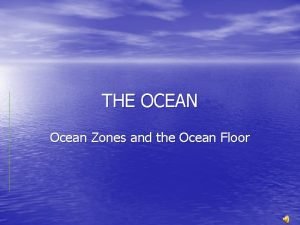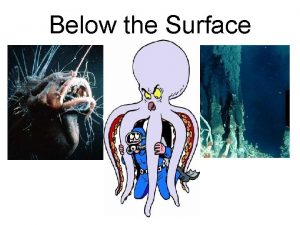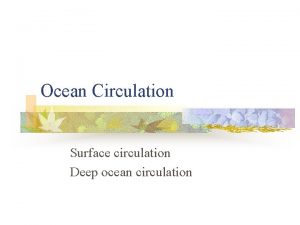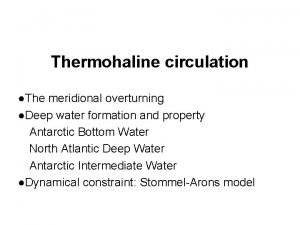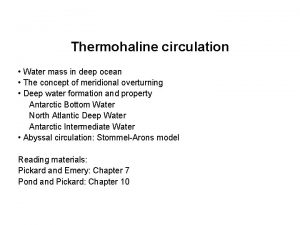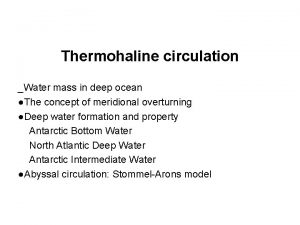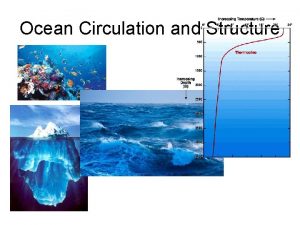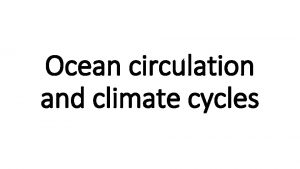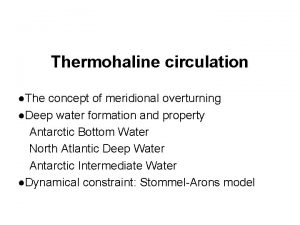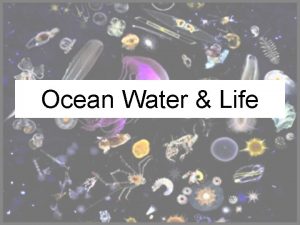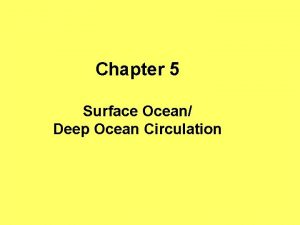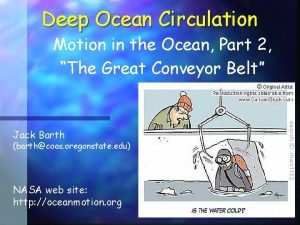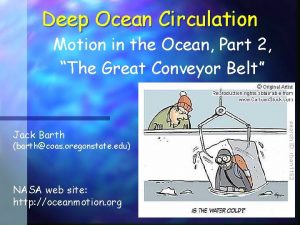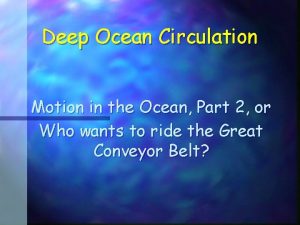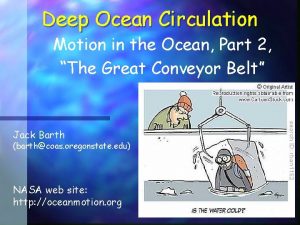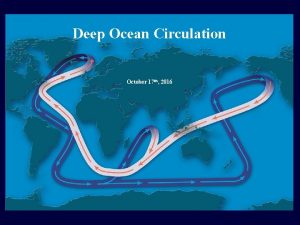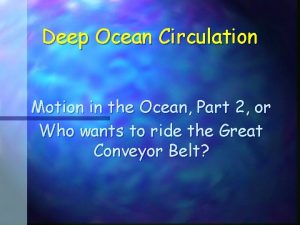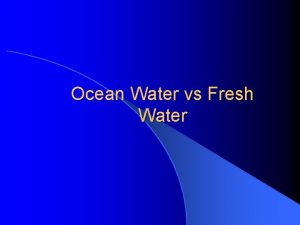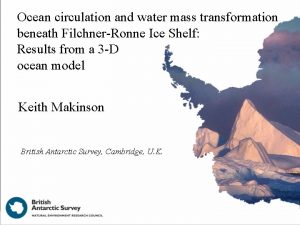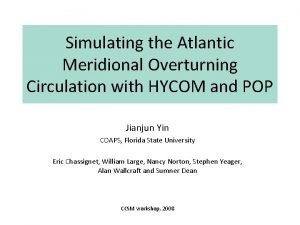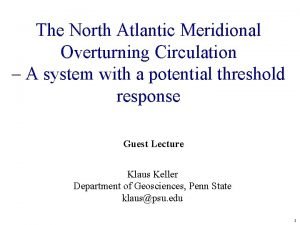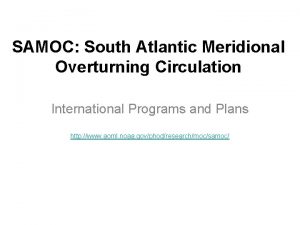Overturning Circulation Water mass in deep ocean Deep























- Slides: 23

Overturning Circulation Water mass in deep ocean Deep water formation and property Antarctic Bottom Water North Atlantic Deep Water Abyssal circulation: Stommel-Arons model Meridional overturning circulation Reading materials: Pickard and Emery: Chapter 7 Pond and Pickard: Chapter 10 Talley, Pickard, Emery and Swift: Chapter 14 Evolution of Physical Oceanography (p 6 -69) Warren: Deep circulation of the world ocean (p 6 -41). Worthington: Water mass of the world ocean(p 42 -69). Pedlosky: Ocean Circulation Theory (p 379 -405)

Upper and Deep Ocean 1). The base of thermocline at a depth of roughly 1 km represents the lower boundary of the domain of the vigorous ocean circulation driven by the wind stress and large-scale distribution of heating and cooling (~upper ocean) 2). Below this region lies a vast volume of water (from 1~2 to 4~5 km, ~deep or abyssal ocean) 3). The deep ocean is cold everywhere T < 4 o. C almost everywhere below 2 km T typically falls within 0 -2 o. C at 4 km In contrast to widespread area of SST of the order of 20 o. C

Why is the deep ocean filled with cold water? • No major heat source or sink within deep ocean (most water properties are set at sea surface) • Waters of such low temperatures can only be originated with surface waters at both polar regions (estimated filling rate: 10 -20 Sv) • The presence at lower latitudes of such waters implies water movement in deep ocean (water properties are helpful for identifying flow path).

Taking into account of the whole set of ocean properties and information about water mass, it is useful to think of the vertical structure in terms of four layers: upper, intermediate, deep, and bottom • Upper: surface mixed layer, thermocline, halocline, pycnocline etc. (in contact with the atmosphere (directly or through broad flow, e. g. , through subduction process). • The other layers are all below pycnocline, identified by water masses that indicate surface origins, with respect to location and formation processes.

Potential temperature-salinityvolume ( -S-V) diagrams for (a) the whole water column and (b) for waters colder than 4°C. The shaded region in (a) corresponds to the figure in (b). Source: From Worthington (1981). Letter in (a): (A) Subantarctica (B) North Pacific and eastern South Paicifc (C) South Pacific and subtropical North Pacific (D) South Atlantic, South Pacific and Indian Ocean (E) South Atlantic and Indian Ocean (F) Western North Atlantic, Red Sea water in Indian Ocean (G)South Pacific (H) 18 o. C water in western North Atlantic FIGURE 4. 17 TALLEY Copyright © 2011 Elsevier Inc. All rights reserved

Deep Water Masses have distinct characters Volumetric T-S Diagram


Thermohaline Circulation Water renewal in deep ocean is mainly achieved by currents which are driven by density differences produced by temperature (thermal) and salinity (haline) effects. The associated circulation is therefore referred to as thermohaline circulation. Since these movements are probably weak, it is often impractical to use current meters to measure them directly; they are usually deduced from the distribution of water properties and the application of geostrophy.

Heating at low latitudes Surface heating at the equator and cooling at higher latitudes generate meridional density difference that drives an overturning cell The overturning circulation is weak because the heat is in the shallow mixed layer The salinity effect (e. g. , evaporation at subtropics and precipitation near the equator) enhances the tropical-subtropical thermal cell but counters the cooling in the higher latitudes with freshening The upper thermohaline cell is of secondary importance

Cooling at high latitudes • Net heat loss from the oceans at high latitudes • Cooling of the surface water and increase in density • Sink and replace deeper water • Density can also be increased when ice freezes out, ejecting salt and thus increasing the weight of the remaining water • Thermohaline circulation of the ocean is associated sinking to mid-depth or even to the ocean bottom.

Water mass formation by deep convection Deep convection occurs in regions of weak density stratification (mostly in polar and subpolar regions). When the water in the mixed layer gets denser than the water below, it sinks to great depth, in some regions reaching to the ocean floor. The density increase can be achieved by cooling or an increase in salinity (either through evaporation or through brine concentration during freezing) or both.

Sea Ice Covers 6 -8% of ocean High reflectivity (Albedo 30 -40%) (A barrier to solar radiation) Always colder than underline water (heat flux from ocean to the ice)

Near Boundery Sinking 1). Dense water forms over the continental shelf, due to surface cooling and salt rejection during ice formation. The resulting convection yields cold, salty water at the depth on the shelf 2). Horizontal density gradient parallel to the coast produces local circulations for the reservoir to empty 3). Mixing with an offshore water mass increases the density (cabbeling) 4). Dense, salty water on the shelf descends the slope under a balance of Coriolis, gravity, and frictional forces. The thermobaric effect may also contribute to the sinking

Sources of Antarctic Bottom Water Sinking around Antarctica The bottom water originates in several areas of the Antarctic continental shelf, where water is made sufficiently cold and saline that, in flowing down the continental slope and mixing with the surrounding deep water, it is dense enough to reach the floor of the ocean. In order of decreasing amount and extent of influence on the deep water property distributions—and presumably, therefore, of rate of bottom water production—these regions are the Weddell Sea, the Ross Sea, and the Adélie Coast; perhaps there is some production off Enderby Land, too.


Weddell Sea The deep water is formed at the continental shelf, which then flow into the Weddell Sea (-2 o. C, S=34. 4~34. 8, t=27. 96) The shelf water mixes rapidly into the water above to form the Weddell Sea Bottom Water ( = – 0. 7 o ~ – 0. 8 o. C, t=27. 9). It is estimated that the net flow out of the Weddell Sea is about 16 x 106 m 3/s. The Weddell Sea Bottom Water is very cold but fresher than the overlaying water (S~34. 52).

Observations made in 1968 on a station line running eastward from Antarctic Peninsula into Weddell Sea.

ity lin Sa The evidence points to a flow of shelf water down the slope, entraining and being diluted by the surrounding water on its way. (The continental shelf is unreachable throughout a year because of ice cover). Potential temperature Observations made in 1968 on a station line running eastward from Antarctic Peninsula show a 200 -m thick layer of relatively cold, fresh, low-silica bottom water on the slope, extending onto the floor of the Weddell Sea. Dissolved silica concentration Similar sections near 40 o. W, 29 o. W, 10 o. W-20 o. W show that the down slope flow gradually diminishes to the eastward.

The distribution of bottom potential temperature in the Weddell Sea demonstrates that the newly formed bottom water leaves the continental slope mainly at the northern tip of the Antarctic Peninsula, near 63 o-65 o. S. At the edge of the continental shelf, the water has = – 1. 2 to – 1. 4 o. C the rate of sinking is 2 -5 x 106 m 3/s.

Other Sources of the Bottom Water Ross Sea More saline and denser water (S>34. 72, t=28. 1 ) are found near the bottom of ocean in the southwestern Pacific, north of the Ross Sea near the mid-ocean ridge (about 65 o. S), and close to Antarctica south of Australia. This high salinity bottom water can be traced back to the deep depressions on the shelf of Ross Sea. The cold saline shelf water has been observed to descend the western continental slope in a manner similar to that of the down slope flow in the Weddell Sea. The off shelf flux is roughly 0. 6 x 106 m 3/s Adélie Coast Deep depressions of much smaller area on the continental shelf of the Adélie Coast of Antarctica. They are filled below their sill depths with water temperature close to the freezing point, and of salinity 34. 4— 34. 7, probably as a result of deep convection associated with winter sea-ice formation. Such water spilling over the sills forms a layer a few tens of meters thick on the near-by continental slope, underlying the high salinity bottom water from the Ross Sea. The flow down the continental slope appears intermittent. This low-salinity bottom water mixes into the Ross Sea water rapidly enough that it has not been detected far from the continental rise near its point of origin. Enderby Land Small amount of bottom water production.

Antarctic Bottom Water • Bottom water from these several sources mixes with the warmer, more saline water above (the Antarctic Circumpolar Water) to form the “Antarctic Bottom Water” of the world ocean. ( t =27. 96, T=0. 3 o. C, S=34. 7 -34. 8 at sub-Antarctic zone 40 -50 o. S). • The Antarctic Bottom Water is the coldest, and the densest, deep water in the open ocean, detectable into northern latitudes by low temperatures close to the bottom. • The Antarctic Bottom Water flows into the South Atlantic and eastward through the Indian and Pacific sectors of the Southern Ocean. Below 4000 m depth, all Atlantic Ocean basins are mainly occupied by the Antarctic Bottom Water.

Passages of AABW The path of Antarctic Bottom Water is strongly affected by the topography. The water mass spreads northward from both east and west of the Mid-Atlantic Ridge. On the western side, it is detectable well into the northern hemisphere past 50 o. N. On the eastern side, the water flows along the Walvis Ridge (20 o. S-30 o. S). Since the basin is closed in the north below the 3000 m level at the Walvis Ridge, its northward progress comes to a halt there. The flow follows the depth contours in cyclonic motion, and the bottom water leaves the basin on the eastern side toward s the Indian Ocean. Antarctic Bottom Water enters the eastern basins north of the Walvis Ridge near the equator by passing the Romanche Fracture Zone. As a result, potential temperature increases slowly both northward and southward from the equator in the eastern basins.

The effect of bottom topography on AABW
 Atlantic meridional overturning circulation
Atlantic meridional overturning circulation Atlantic meridional overturning circulation
Atlantic meridional overturning circulation Single circulation and double circulation
Single circulation and double circulation Single circulation and double circulation
Single circulation and double circulation Types of alveoli
Types of alveoli Chapter 15 ocean water and ocean life
Chapter 15 ocean water and ocean life Water and water and water water
Water and water and water water Slowing atlantic ocean circulation
Slowing atlantic ocean circulation Retaining wall
Retaining wall Overturning moment
Overturning moment Conveyor belt
Conveyor belt Water circulation
Water circulation Convergent vs divergent plate boundaries
Convergent vs divergent plate boundaries Ocean ocean convergent boundary
Ocean ocean convergent boundary Convergent boundary
Convergent boundary Ocean ocean convergent boundary
Ocean ocean convergent boundary Ocean to ocean convergent boundary
Ocean to ocean convergent boundary Ocean to ocean convergent boundary
Ocean to ocean convergent boundary Blue ocean strategy canvas
Blue ocean strategy canvas The deep ocean floor that is nearly flat
The deep ocean floor that is nearly flat Deep valley on the ocean floor
Deep valley on the ocean floor Smooth nearly flat region of the ocean floor
Smooth nearly flat region of the ocean floor Figure of speech about love
Figure of speech about love Deep sea abiotic factors
Deep sea abiotic factors
